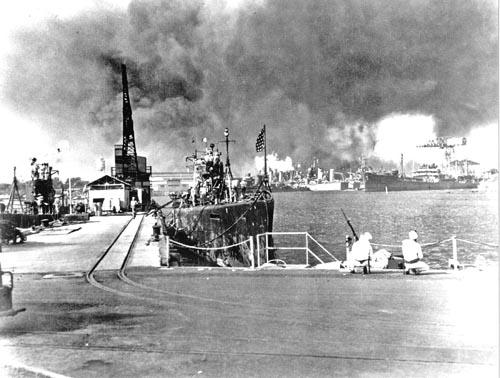School children all over the nation are taught the date of the
attack on Pearl Harbor, December 7, 1941, and as another
anniversary of the day that will live in infamy passes, WWII
survivors are eager to share their stories and pass on their
experience to younger generations.
Frank Sennello, president of the local chapter of the Pearl
Harbor Survivors said his group has reduced its activities due to
the age of its membership but still enjoyed sharing their
memories.
Sennello’s chapter covers all of Northern California, beginning
in Marin County and heading north to the state border. At its peak
the association had 150 members, but Sennello said it’s now down to
approximately 16 and most of its current membership has difficulty
traveling long distances.
Over the past 20 years the Pearl Harbor survivors have spoken to
more than 40,000 people, mostly students at local high schools, and
given more than 1,500 presentations. Sennello said most audience
members walk away with a deeper appreciation for the immense
sacrifices that were necessary during that time. “Usually we try to
tell them what the country was like back then and how different it
seems,” he said. “We talk about the miracle of Pearl Harbor and the
miracle this country performed,” Sennello said the “miracle”
included rapidly mobilizing an army of more than 14 million and
gearing up a massive war time production economy in a population
that had been hesitant to support a war prior to the Pearl Harbor
attacks.
Senello said presentations always included time for questions as
students were eager to hear personal details from veterans. “They
want to know ‘what did you do?’ ‘What did a day look like for
you?’”
He said the experience helped put America’s current political
framework into a historical context and that after learning about
history from dry books, audiences jumped at the chance to hear
details direct from those who lived through important events.
Nico Saldana, social studies department representative at
Windsor High School said having a real person share their
experiences with students was an important part of their education.
“Without a doubt it’s very important,” he said. “You can’t ask for
anything better than a primary source and with someone that lived
it or was there, you’re getting a living source, it’s terrific. The
students really buy into it because it’s not the teachers.”
Senello was stationed at Pearl Harbor’s submarine base, a short
distance from the docked battleships that became the focus of the
assault. He said he was preparing to shave when his buddy called
him over to a window to see several planes dive toward the area.
“At that moment we didn’t realize they were japanese planes, as
soon as we realized, when we saw smoke and fire, we ran down to the
basement and grabbed rifles.”
Unsure as to whether the attack would include a landing, Senello
and his friend Richard Grifiths, equipped their guns with bayonets
and ran outside where they were captured on film by a photographer
alongside the submarine Narwhal.
Windsor resident Howard Arrasmith also served in submarines
during WWII and is a member of the Submarine Veterans of WWII
Sacramento chapter. He said his age prevents him from attending as
many meetings as he would like. “There are very few of us left and
I’m one of the young ones,” said Arrasmith at age 84. He said the
organization still gave out two scholarships a year which helped to
fulfill the organization’s purpose to “perpetuate and remember our
comrades on eternal patrol.”
While many families were separated for years during WWII,
Arrasmith said he was fortunate enough to have met his brother,
Donald, twice during the duration of his service. The pair met at a
submarine base in Australia and again in San Francisco. Arrasmith
said he enjoyed his work and eventually settled in California due
to his positive memories of San Francisco.
Arrasmith wasn’t at Pearl Harbor and had been turned down by the
Navy prior to Pearl Harbor for medical reasons but was able to sign
up after receiving surgery and eventually found himself surviving
depth charges in a S-class submarines that had been commissioned
more than 20 years before the Japanese attacks. “We figured we were
pretty lucky to survive,” he said. “It’s like being in a metal
barrel and having two or three people hitting you with sledge
hammers. Very scary.”
Pearl Harbor survivor Tom Bates also said he was lucky to
survive through the war but while Arrasmith and Senello were on
submarines, Bates’ small destroyer, the Ramsey, was out hunting
enemy subs.
Bates said his ship, wasn’t large enough to be a target during
the Pearl Harbor attacks and that while his ship engaged in combat,
he couldn’t see anything from his position in the boiler room. “It
was a good job,” he said with a smile. “Only 95 to 110 degrees down
there. It was as low as you could get. We used to say if they hit
the ship we’d have to swim up to the top.”
The Ramesy destroyed two enemy submarines during its tour of
duty and Bates’ second ship The Anzio was awarded a presidential
unit citation at the conclusion of the war.
The veterans said they felt the public was appreciative of their
roles in world history and hoped their experiences would help
future generations understand their heritage. “(students) love
their country and they want to know about it,” said Senello.
Educators who would like to bring Pearl Harbor survivors into
their classes can contact Senello at 568-3837.
46.5
F
Healdsburg
April 19, 2025








